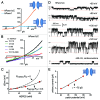Intrinsic properties and regulation of Pannexin 1 channel
- PMID: 24419036
- PMCID: PMC4048298
- DOI: 10.4161/chan.27545
Intrinsic properties and regulation of Pannexin 1 channel
Abstract
Pannexin 1 (Panx1) channels are generally represented as non-selective, large-pore channels that release ATP. Emerging roles have been described for Panx1 in mediating purinergic signaling in the normal nervous, cardiovascular, and immune systems, where they may be activated by mechanical stress, ionotropic and metabotropic receptor signaling, and via proteolytic cleavage of the Panx1 C-terminus. Panx1 channels are widely expressed in various cell types, and it is now thought that targeting these channels therapeutically may be beneficial in a number of pathophysiological contexts, such as asthma, atherosclerosis, hypertension, and ischemic-induced seizures. Even as interest in Panx1 channels is burgeoning, some of their basic properties, mechanisms of modulation, and proposed functions remain controversial, with recent reports challenging some long-held views regarding Panx1 channels. In this brief review, we summarize some well-established features of Panx1 channels; we then address some current confounding issues surrounding Panx1 channels, especially with respect to intrinsic channel properties, in order to raise awareness of these unsettled issues for future research.
Keywords: ATP release; P2X receptor; Pannexin 1; ionic selectivity; unitary conductance.
Figures

Similar articles
-
Pannexin1 channels act downstream of P2X 7 receptors in ATP-induced murine T-cell death.Channels (Austin). 2014;8(2):142-56. doi: 10.4161/chan.28122. Epub 2014 Mar 3. Channels (Austin). 2014. PMID: 24590064 Free PMC article.
-
The food dye FD&C Blue No. 1 is a selective inhibitor of the ATP release channel Panx1.J Gen Physiol. 2013 May;141(5):649-56. doi: 10.1085/jgp.201310966. Epub 2013 Apr 15. J Gen Physiol. 2013. PMID: 23589583 Free PMC article.
-
Interactions of Pannexin1 channels with purinergic and NMDA receptor channels.Biochim Biophys Acta Biomembr. 2018 Jan;1860(1):166-173. doi: 10.1016/j.bbamem.2017.03.025. Epub 2017 Apr 4. Biochim Biophys Acta Biomembr. 2018. PMID: 28389204 Free PMC article. Review.
-
Amplification of human platelet activation by surface pannexin-1 channels.J Thromb Haemost. 2014 Jun;12(6):987-98. doi: 10.1111/jth.12566. J Thromb Haemost. 2014. PMID: 24655807 Free PMC article.
-
Revisiting multimodal activation and channel properties of Pannexin 1.J Gen Physiol. 2018 Jan 2;150(1):19-39. doi: 10.1085/jgp.201711888. Epub 2017 Dec 12. J Gen Physiol. 2018. PMID: 29233884 Free PMC article. Review.
Cited by
-
D-serine released by astrocytes in brainstem regulates breathing response to CO2 levels.Nat Commun. 2017 Oct 10;8(1):838. doi: 10.1038/s41467-017-00960-3. Nat Commun. 2017. PMID: 29018191 Free PMC article.
-
Panx1 knockout promotes preneoplastic aberrant crypt foci development in a chemically induced model of mouse colon carcinogenesis.Int J Exp Pathol. 2023 Dec;104(6):304-312. doi: 10.1111/iep.12491. Epub 2023 Aug 18. Int J Exp Pathol. 2023. PMID: 37594023 Free PMC article.
-
Effects of Hypoxia on Erythrocyte Membrane Properties-Implications for Intravascular Hemolysis and Purinergic Control of Blood Flow.Front Physiol. 2017 Dec 22;8:1110. doi: 10.3389/fphys.2017.01110. eCollection 2017. Front Physiol. 2017. PMID: 29312010 Free PMC article. Review.
-
The Cryo-EM structure of pannexin 1 reveals unique motifs for ion selection and inhibition.Elife. 2020 Feb 12;9:e54670. doi: 10.7554/eLife.54670. Elife. 2020. PMID: 32048993 Free PMC article.
-
ATP release through pannexon channels.Philos Trans R Soc Lond B Biol Sci. 2015 Jul 5;370(1672):20140191. doi: 10.1098/rstb.2014.0191. Philos Trans R Soc Lond B Biol Sci. 2015. PMID: 26009770 Free PMC article. Review.
References
Publication types
MeSH terms
Substances
Grants and funding
LinkOut - more resources
Full Text Sources
Other Literature Sources
